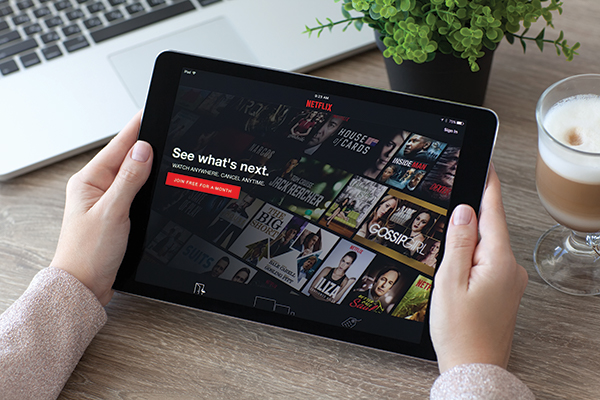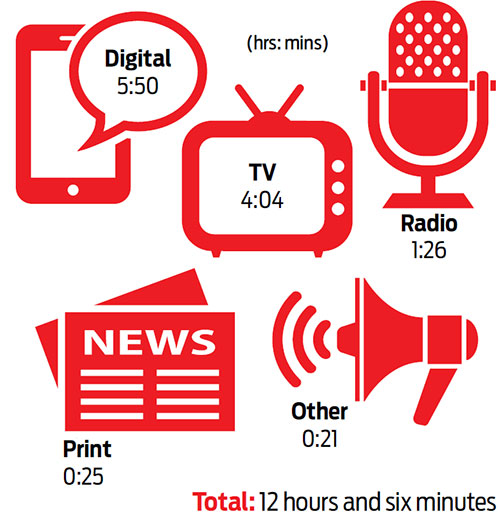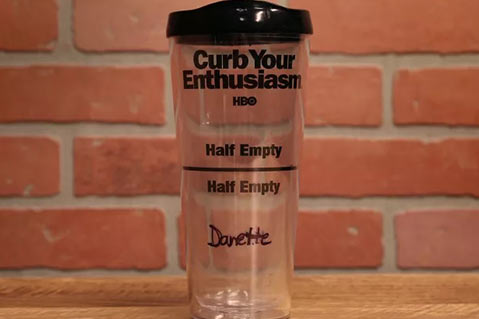May 07, 2018
Promo Market To Target: Entertainment
Today’s pop culture junkie has endless ways to consume media – which means entertainment companies need promo products to stand out from the crowd.
Entertain this thought: Americans last year spent over 12 hours a day consuming media. Each day, we’re watching four hours of TV and perusing nearly six hours of digital content – often at the same time. The reason? Thanks to the streaming revolution and our smartphone addictions, video, music and much more are always at our fingertips. Entertainment has never been more accessible.
That simple fact has completely transformed the entertainment industry. Take TV as an example. In 2016, there were 455 scripted shows (roughly a third of all prime-time TV series). A decade prior, there were 192.
>>Don't Miss! Rise in Music Merch Means Opportunity for Promo Industry
And what about how people watch those shows? Americans do watch more TV than ever – but 61% of young adults now say they use streaming services more than network television.
He’s an actor and an entrepreneur. And Mark Wahlberg also is a T-shirt lover. Watch as the star professes his love for supplier Bella+Canvas (asi/39590).
Thus is born an interesting dynamic: more entertainment providers than ever, all of them straining to reach viewers as their consumption habits dramatically change. That sense of urgency is creating a renewed reliance on promotional products. “To stand out in the noise of all the great content, a great marketing strategy is imperative,” says Summer Barry, creative and marketing director at Bella+Canvas (asi/39590) in Los Angeles. “It’s not enough to just do outdoor advertising anymore. Pop-up events and grassroots marketing initiatives are very important.”
Creative Medium
The entertainment industry is constantly seeking products that recognizably tie to the show or film in question, says Alexis Bernard, senior branding specialist at Axis Promotions (asi/128263) in New York. “Everything should be extremely exciting and on-brand for their shows or their artists,” she says. “It doesn’t so much matter what the product is … it’s more what represents their show, their event and capturing the feel of what they’re trying to do.”
To that end, distributors and suppliers recommend that entertainment promos have bright colors, prominent calls to action and be of the utmost quality and function.
Stephanie Woods, brand marketing consultant and owner of Limelight Branding in Los Angeles and Orange County, CA, says the promotional products found in entertainment are “fun, functional and retail relevant.”
“It’s a lot more creative than the Your Logo Here things you find in corporate,” says Woods, an affiliate of Boundless (asi/143717) who works with Warner Bros. Studios.
Heidi Perrault, an entertainment industry account executive at Halo Branded Solutions (asi/356000), recently worked on promotional products for the film Pitch Perfect 3, a franchise that according to Variety recently hit $500 million in box office sales. The film was released right before Christmas, so Perrault chose an ornament from Christmas by Krebs (asi/44989). “The supplier was able to very expeditiously pull together those orders and ship relatively small items at a time,” says Perrault, who is based in Costa Mesa, CA.

Perrault also created custom boot socks with images of the movie title woven in. “Custom socks have been huge,” Woods says. “They have a big function, they’re wearable, they’re unisex and you don’t have to worry about sizing. It checks a lot of boxes.”
Bernard points out that repeat events, such as South by Southwest and Comic-Con, have to be taken into consideration since many end-users attend the same events annually or even throughout the year. “Because they’re all going year after year, the promos have to be fresh,” says Bernard, who works with Starz, Lionsgate and Universal Music Group, “and they’re competing with one another to stand out as a brand, a TV show, or an artist.”
Apparel is loved by the entertainment industry for events like premieres and junkets, but it works best as a high-quality item that people want to wear rather than just a collectible. “Instead of just a plastisol ink print of the movie poster art on the front of the T-shirt, the graphics will feel much more retail,” says Barry, whose company Bella+Canvas has teamed up with actor Mark Wahlberg to outfit his multiple business ventures. Fabric quality matters too, Barry adds, touching on the popularity of combed ringspun cotton.
In addition to a high fun factor, the entertainment industry also wants promotional products that will play well in the Midwest just as easily on the East or West coasts, Perrault says. She cites examples like “flare” buttons and technology-based items such as screen cleaners, mouse pads and Pop Sockets, “which have been hugely popular” in the entertainment industry, she says. Other items Perrault mentions include sunglasses with a customized side wing and a printed sunglasses bag; four-color process journals; and carryall zip pouches Halo produced for the direct-to-video film Monster High, and box-office titles My Big Fat Greek Wedding and Fifty Shades Darker.
To get a sense of what products might work best, a little research is in order. Woods pays close attention to what’s coming up in TV show and movie lineups. “If you can get screeners of pilots in advance to do the research and be well-versed in what the content and message is,” she says, “that helps with figuring out what products would be a little more creative that someone else wouldn’t see.”
The look of these products is key as well, and it’s no surprise that entertainment clients have embraced the latest innovations in digital printing and high-quality graphics. “The clients don’t mind paying an additional run charge to print in full color because of the impact it’ll have and how it’ll be received,” Woods says.
Packaging matters too. “Vibrant and full-color,” says Bernard about the type of packaging that works. “They’re wowing the person upon the first visual of this kit.” The product may just be a $1 handout, she says, but if she’s able to package it in a clever and exciting way and include a call to action, she knows it’ll be a win on all fronts. If a client wanted a silicone phone wallet with a logo on it, for instance, “I might suggest an insert in the phone wallet with additional information,” she says. “The more branding space you can get on a product, the better result you’ll get out of that premium.
Know Your Audience
There’s one dedicated group who certainly eat up promotional merch: fans. Pop culture fanatics not only love their shows and films, they love any item associated with them.
Limelight works on a number of items that are for sale in the store on the 62-acre Warner Bros. lot, which not only employs production personnel of many stripes, but also hosts tours nearly every day. The retail store on the lot gets foot traffic from fans of shows old and new, from Gilmore Girls – for which Limelight did hats based on the show’s iconic Luke’s Diner – to The Big Bang Theory, Woods says.
“These items are designs and concepts fans will be drawn to, promoting film and TV that are actually produced on the lot,” Woods says. “Many of the products are very fan-focused. This is for the fan that knows the catchphrases and maybe has all the DVDs.”
There are a number of other ways to reach fans. For example, live audiences at shows may receive promotional products; Perrault names The Steve Harvey Show, which she has assisted in ordering T-shirts and water bottles as thank-you gifts for audience members.
Prize-pack giveaways are also popular. For digital releases, Perrault has seen Instagram and Facebook campaigns that have succeeded in incentivizing movie fans to enter a contest. Through the social media pages of Cinemark Theatres, the Fifty Shades official fan club recently promoted an opportunity to win a film-branded blanket. “Those kinds of items are usually higher end because people won’t go to the effort for a screen-cleaner cloth,” Perrault says. “They don’t order as many, but they offer a higher perceived value package.”
Home video also does quite a bit of business in the area of prize packs, Perrault says. “It used to be a huge space for me, but it’s getting smaller and smaller because of digital on demand,” she says, but she still does several catalog programs, promotions such as buying any NBC title at Christmas – like Jaws or 16 Candles – and receiving a license-free promo product CD with it.
 Today’s U.S. adult consumes about two more hours of media than a decade ago. The simple reason? Device multitasking, such as checking social media while watching TV. (Time spent for each activity is measured separately even when occurring at the same time.) More than half of our digital activity is on mobile – and growing.
Today’s U.S. adult consumes about two more hours of media than a decade ago. The simple reason? Device multitasking, such as checking social media while watching TV. (Time spent for each activity is measured separately even when occurring at the same time.) More than half of our digital activity is on mobile – and growing.
There’s another way to sway fans – through social media influencers, a practice the entertainment industry has leaned heavily upon in recent years, says Bernard. Entertainment companies are often making first contact by sending a slew of branded, utilitarian products. “They’re making sure the products are on-brand with what they’re presenting, and that these items are useful for the recipient,” Bernard says. “It’s usually something someone blogging all day long would find useful.”
Of course, not every promo hits the mark. As proof, the entertainment website The A.V. Club puts out an annual compendium titled The Year in Swag, which chronicles the promotional products it receives.
Entertainment companies must also appeal to buyers of a different sort: cable affiliates. New York often hosts what’s known in the television industry as “up front conferences,” where TV networks and digital publishers make annual pitches to media buyers and marketers “in an arms race to snag dollars for next season,” says Ad Age. At those events, Perrault says, it’s not uncommon to see gift sets that include a matching water bottle, journal, coffee mug and Pop Socket designed for the cable affiliates that are shopping for new and existing TV properties.
The entertainment industry also has its share of internal promos. In addition to the items sold on the Warner Bros. lot, Woods often needs promotional products for human resources, corporate and employee engagement. For instance, last summer during a farmers market on the lot, Woods ordered WB-branded grocery totes. Light-up USB drives were doled out at a job fair. T-shirts are created for any time the company participates in charity walks or volunteer events. A recent corporate event for manager-level employees included not only an order of branded banners and table covers, but also decks of 10 cards, each printed with motivational reminders for managers and held together with a money clip.
Companies will also send out gifts to top-tier executives, and according to Bernard, it’s the only time co-branding comes into play. In that scenario, a jacket might be a brand-name jacket, “but every other project I’m working on, they don’t want North Face,” she says.
The Year In Swag
Each year, there are two groups that entertainment companies are particularly trying to impress. One, obviously, are viewers. The other are journalists. And what better way to do that than with promotional products?
Well, for what seems like time immemorial, The A.V. Club has been cataloging the unique (and uniquely weird) swag it receives each year. From a cake finger to a hamburger phone to a bullwhip, the retrospectives clearly demonstrate that the creativity of distributors and their entertainment clients knows no bounds. Check out 2017’s memorable promos and eagerly anticipate this year’s entry in December.

Credit: The A.V. Club
Sarah Protzman Howlett is a contributing writer for Advantages.